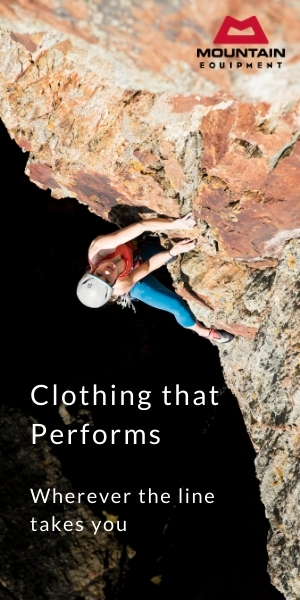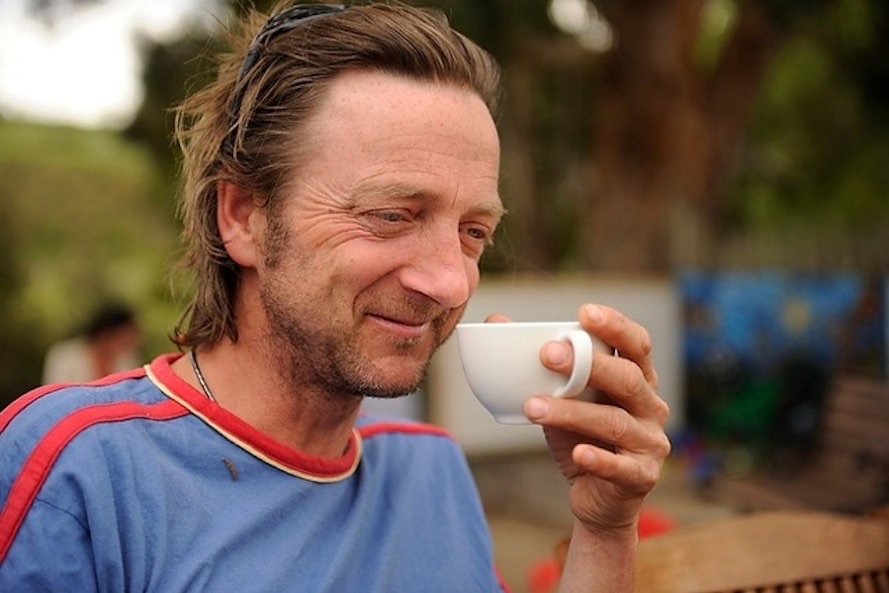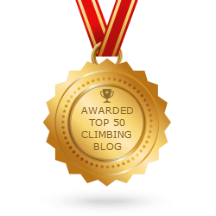Charlie Woodburn is one of the coolest climbers we can think of. He onsights wild routes. His headpoints are impressive. He films - and has flown in helicopters - for a job. He seems content to quietly go to cool places, and do cool things. Charlie also has a severe form of chronic arthritis, which means he's had the extra perspective of just being psyched to walk around in good health. Read on...
You’ve been climbing impressive routes for quite a few years now. What factors have helped you to climb in general, and what’s helped you climb at a high standard?
I’ve been climbing for 32 years now, so I must enjoy it a little, I think. It's interesting in that what facilitates and motivates me to climb evolves over time as life changes and develops. For most people, this usually involves career paths and parenthood, but for me my circumstances delivered no 9-5 job and no kids, which has definitely helped on the ability to put time into climbing.
I’ve always worked as a freelancer in the film industry, and I can’t imagine being tied to a strict 9-5 desk job. I’ve been lucky enough to find what I’d consider to be a healthy balance between work, and time off to climb and go on trips. The downside to this is that work is extremely unpredictable, and regularly changes or comes in with very little notice. Consequently, there’s been numerous times when I've had big trips booked but I’ve had to bail, much to the chagrin of my climbing partners.
There are so many factors that dictate how easily - or otherwise - it is to establish yourself as the climber you want to be. For example, climbers that grow up close to incredible climbing areas or have parents who climb, in a sense, can be spoon fed from an early age; but equally, from aged 18, I had a car and I could travel anywhere easily. Also, making your own mistakes as you learn definitely instills an attitude of responsibility and ownership of your fate that pays dividends. Ultimately, of course, if you're passionate enough you find a way to become the climber you want.
I’ve been climbing for 32 years now, so I must enjoy it a little, I think. It's interesting in that what facilitates and motivates me to climb evolves over time as life changes and develops. For most people, this usually involves career paths and parenthood, but for me my circumstances delivered no 9-5 job and no kids, which has definitely helped on the ability to put time into climbing.
I’ve always worked as a freelancer in the film industry, and I can’t imagine being tied to a strict 9-5 desk job. I’ve been lucky enough to find what I’d consider to be a healthy balance between work, and time off to climb and go on trips. The downside to this is that work is extremely unpredictable, and regularly changes or comes in with very little notice. Consequently, there’s been numerous times when I've had big trips booked but I’ve had to bail, much to the chagrin of my climbing partners.
There are so many factors that dictate how easily - or otherwise - it is to establish yourself as the climber you want to be. For example, climbers that grow up close to incredible climbing areas or have parents who climb, in a sense, can be spoon fed from an early age; but equally, from aged 18, I had a car and I could travel anywhere easily. Also, making your own mistakes as you learn definitely instills an attitude of responsibility and ownership of your fate that pays dividends. Ultimately, of course, if you're passionate enough you find a way to become the climber you want.

Charlie filming as part of the film Black Hawk Down. Photo: Charlie Woodburn Collection
In terms of climbing partners, I’ve never had a regular partnership apart from my first few years climbing with one of my best mates from school: Mark Campbell. We made all the chaotic mistakes that beginners make together, and we grew up as climbers together. Ultimately, he gravitated towards hardcore bouldering and my tastes took me towards scary trad for weak people.
To me, climbing with a myriad of different people is part of the joy of climbing. The personality of your climbing partner plays a huge part in the pattern of the climbing experience. I’m fascinated by watching other climbers and how they deal with pressure, risk, minimal discomfort, how positive or optimistic they are, how they appreciate the climbing experience beyond the basic tick... ultimately, how they get the best (or worst) out of themselves. I’ve learnt a lot from climbing with many many different people.
I don’t consider myself a naturally good climber at all. People remember the harder ascents, but 99% of the time I’m climbing really shit. The only thing I think I’m naturally good at is trying really, really, really hard. Sometimes I see strong climbers trying something and then they suddenly fall off and there's a little whinge about skin or conditions or polish or some bollocks, and I don’t reckon they’ve even reached 90% 'try hard.' Beyond 90% try hard, things get ugly. I mean, really grotesque. And some people are uncomfortable with ugly, especially in the social media epoch.
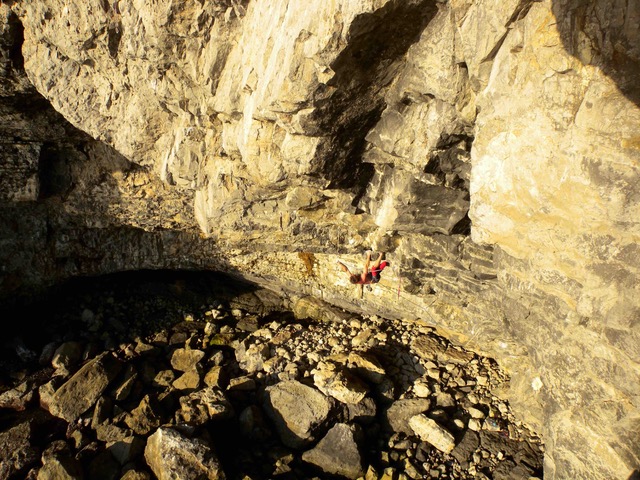
Charlie on Infinite Gravity (8a+), Swanage. Photo: Charlie Woodburn Collection
You’ve also managed a long-term illness (a form of chronic arthritis), which is amazing in that it doesn't seem to hold you back - but it this just part of the story?
Well, in short, it does hold me back. But absolutely everybody out there has something that will hold them back at some point or other. I’m not going to lie; there's been plenty of times in my life where the I’ve reached 'peak whinge' about unfairness and ‘why me?’. Living life in constant pain is no joke. However, there’s not been a single time when all the complaining and raging and sadness did anything to actually help.
Now, I prefer to look at the benefits - of which there are many. For example, I learnt to take control of uncertainty in life (the doctors told me I’d be unable to climb by my 30’s) and be quite sanguine about it. I’ve experimented vastly with how to treat my condition and had to open my mind considerably. And these are things that have helped me in all walks of life. It's taught me patience and to genuinely seize the moments of opportunity when and if they come (see above 'try hard' waffle).
There’s been many, many times when I’ve been unable to walk - let alone climb. It’s in these times that I’ve learnt what a privilege it is to have the mental resources to be even bothered about climbing. I mean, if you’re waking up every morning thinking how psyched you are to train or send your project, then things are going really well in your life. I’ve learnt that everything is cyclical, and however bad things are, there will be a time when it will get better.
Well, in short, it does hold me back. But absolutely everybody out there has something that will hold them back at some point or other. I’m not going to lie; there's been plenty of times in my life where the I’ve reached 'peak whinge' about unfairness and ‘why me?’. Living life in constant pain is no joke. However, there’s not been a single time when all the complaining and raging and sadness did anything to actually help.
Now, I prefer to look at the benefits - of which there are many. For example, I learnt to take control of uncertainty in life (the doctors told me I’d be unable to climb by my 30’s) and be quite sanguine about it. I’ve experimented vastly with how to treat my condition and had to open my mind considerably. And these are things that have helped me in all walks of life. It's taught me patience and to genuinely seize the moments of opportunity when and if they come (see above 'try hard' waffle).
There’s been many, many times when I’ve been unable to walk - let alone climb. It’s in these times that I’ve learnt what a privilege it is to have the mental resources to be even bothered about climbing. I mean, if you’re waking up every morning thinking how psyched you are to train or send your project, then things are going really well in your life. I’ve learnt that everything is cyclical, and however bad things are, there will be a time when it will get better.
Each time this happens, it's back to square one with training and working hard to get to the physical and mental best you can be. I think it was Adam Lincoln that said “Woodburn’s had more comebacks than Status Quo”.
Ultimately though, I’ll always come back to climbing because it's just so good on every level. I’ll always climb, because at any grade it's still brilliant. In this age of CV-19 lockdown, the whole world is going bananas at the fact they can’t do exactly what they want to do, when they want to do it. Most people haven’t discovered yet that fate doesn’t owe us anything, and you make your own reality by how you respond to every event in life... and that includes skin, conditions and polish.
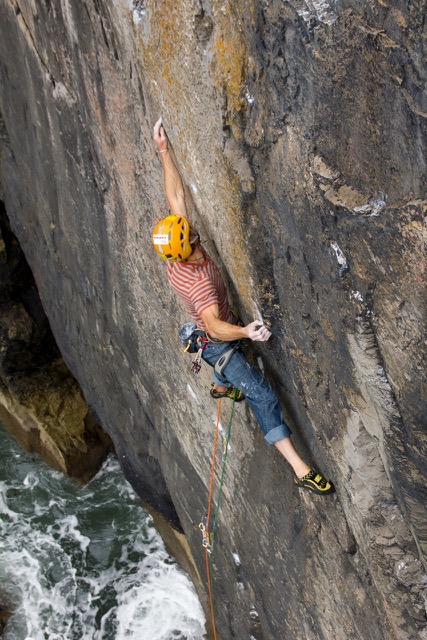
Charlie on Something's Burning (E9 6c), Pemrboke. Photo: Charlie Woodburn Collection
What prompted your psyche for Skye Wall [Dave Birkett’s stunning E8 on Skye]?
Just look at it. I probably have to thank Alistair Lee’s photos for that. I got into climbing via hill walking with my dad, and the Cuillins were the place I would daydream about at school. When I got into climbing, the focus shifted from summits, to crags, sea cliffs and grit edges. But seeing that wall, in that location, felt like merging a passion for stunning rock faces with my childhood obsession with Scotland's Munroes and W.A. Poucher’s Cuillins. I’m basically a sentimental at heart.
Just look at it. I probably have to thank Alistair Lee’s photos for that. I got into climbing via hill walking with my dad, and the Cuillins were the place I would daydream about at school. When I got into climbing, the focus shifted from summits, to crags, sea cliffs and grit edges. But seeing that wall, in that location, felt like merging a passion for stunning rock faces with my childhood obsession with Scotland's Munroes and W.A. Poucher’s Cuillins. I’m basically a sentimental at heart.

Charlie on Skye Wall (E8 6c), Skye. Photo: Charlie Woodburn Collection
What’s the story involving you and a bridge in London?!
A while ago, On The Edge magazine wanted to run an article about buildering [urban bouldering] in London. There weren't many climbers in London in those days, and the photographer James Avery Cunliffe asked me to come and pose for some shots. We messed around on some contrived-looking things, but really wanted the money shot to look dramatic and really scream ‘London’. We were on the South Bank, and looking straight past Southwark bridge was St Paul's Cathedral. On a telephoto lens, with the perspectives squashed up, a climber hanging off the bridge above the Thames would look cool as f**k.
I checked the Thames Police timings, and they seemed to go up and down, and under the bridge, every half an hour. Also, I’d been with Leo Houlding the year before, when he got arrested for climbing the Angel Of The North, and he’d got let off with a caution, so I figured “what’s the worst that could happen?”
So I ran along the top of the bridge to the central arch, and then climbed over and down the stone column to the base of the arch. Then I hand-over-handed to the middle, about 70 ft above the Thames. A boat full of Japanese tourists saw me and started shouting and taking pictures, presumably because they thought that I was about to top myself.
Then, of course, the Old Bill turned up in four different boats, and started putting their megaphones to some considerable use. I climbed out, expecting there to a swarm of Coppers on the bridge, but there was no-one. James came running over and we scarpered. Then this cop car comes screaming down the road and pulls onto the pavement, arresting me but letting James go. Turns out I’d badly misjudged the situation - who knew?!
For the next three or four hours, I was locked in the back of a police van on the bridge while they closed the bridge and the River Thames, and got the Bomb Squad to search the bridge. When being questioned by the Detective, I asked him “do I look like a terrorist?” to which he replied “what does a terrorist look like?” which is a fair point. This all happened in 2000, so before 9/11. It seems crazy to think about how blasé I was about it, but it was a different time: I was in my 20’s and just free-styling in the moment, the way things should be (maybe).
After three months there was a hearing, and I pleaded 'not guilty' to Disorderly Conduct. It then went to trial another three months later, but the Crown Prosecution Service withdrew the charges the day before trial, and my journey of wasting taxpayer's time and money was finally complete.
A while ago, On The Edge magazine wanted to run an article about buildering [urban bouldering] in London. There weren't many climbers in London in those days, and the photographer James Avery Cunliffe asked me to come and pose for some shots. We messed around on some contrived-looking things, but really wanted the money shot to look dramatic and really scream ‘London’. We were on the South Bank, and looking straight past Southwark bridge was St Paul's Cathedral. On a telephoto lens, with the perspectives squashed up, a climber hanging off the bridge above the Thames would look cool as f**k.
I checked the Thames Police timings, and they seemed to go up and down, and under the bridge, every half an hour. Also, I’d been with Leo Houlding the year before, when he got arrested for climbing the Angel Of The North, and he’d got let off with a caution, so I figured “what’s the worst that could happen?”
So I ran along the top of the bridge to the central arch, and then climbed over and down the stone column to the base of the arch. Then I hand-over-handed to the middle, about 70 ft above the Thames. A boat full of Japanese tourists saw me and started shouting and taking pictures, presumably because they thought that I was about to top myself.
Then, of course, the Old Bill turned up in four different boats, and started putting their megaphones to some considerable use. I climbed out, expecting there to a swarm of Coppers on the bridge, but there was no-one. James came running over and we scarpered. Then this cop car comes screaming down the road and pulls onto the pavement, arresting me but letting James go. Turns out I’d badly misjudged the situation - who knew?!
For the next three or four hours, I was locked in the back of a police van on the bridge while they closed the bridge and the River Thames, and got the Bomb Squad to search the bridge. When being questioned by the Detective, I asked him “do I look like a terrorist?” to which he replied “what does a terrorist look like?” which is a fair point. This all happened in 2000, so before 9/11. It seems crazy to think about how blasé I was about it, but it was a different time: I was in my 20’s and just free-styling in the moment, the way things should be (maybe).
After three months there was a hearing, and I pleaded 'not guilty' to Disorderly Conduct. It then went to trial another three months later, but the Crown Prosecution Service withdrew the charges the day before trial, and my journey of wasting taxpayer's time and money was finally complete.
Which of your hard headpoints are you most satisfied with? And the same for onsights?
For headpoints, Harder Faster [an E9 6c at Black Rocks] because, as well as being my first new route, it was the first route that really felt like it tested me psychologically. The aspirational grit routes of the time were the classics like Master’s Edge, Gaia, and End Of The Affair. But when I finally did these routes (headpoint style), they never really felt that hard - if I’m gonna be honest. It's amazing how much easier headpointing makes an ascent, compared to onsighting. I mean, it makes the ascent so much easier, and I discovered this on those routes. I wasn't good enough to onsight them but headpointing them felt quite easy. It seemed, at the time, like no-one had really pushed the boat out with headpointing, except a few exceptions like Indian Face, Meshuga, and New Statesman.
The line had been tried by many, and so it’s easy to think, if 'so and so can’t do it, it must be too hard.' But trying this route taught me to never take anyone else's word for it. Harder Faster is a classic head game. The climbing is easy-ish if you're calm and focused, and deadly if you aren’t. That's the game: find a way to stay calm. These days, people are all over the mental side of things on a performance level, but not on an existential level. Pussies.
For headpoints, Harder Faster [an E9 6c at Black Rocks] because, as well as being my first new route, it was the first route that really felt like it tested me psychologically. The aspirational grit routes of the time were the classics like Master’s Edge, Gaia, and End Of The Affair. But when I finally did these routes (headpoint style), they never really felt that hard - if I’m gonna be honest. It's amazing how much easier headpointing makes an ascent, compared to onsighting. I mean, it makes the ascent so much easier, and I discovered this on those routes. I wasn't good enough to onsight them but headpointing them felt quite easy. It seemed, at the time, like no-one had really pushed the boat out with headpointing, except a few exceptions like Indian Face, Meshuga, and New Statesman.
The line had been tried by many, and so it’s easy to think, if 'so and so can’t do it, it must be too hard.' But trying this route taught me to never take anyone else's word for it. Harder Faster is a classic head game. The climbing is easy-ish if you're calm and focused, and deadly if you aren’t. That's the game: find a way to stay calm. These days, people are all over the mental side of things on a performance level, but not on an existential level. Pussies.

Charlie on the FA of Harder Faster (E9 6c), Black Rocks. Photo: Charlie Woodburn Collection
The Walk Of Life was extremely satisfying because it's probably the best route I’ve done anywhere. It's a slab. It's a sea cliff. It's beautiful. If you like that sort of thing, then there’s an awful lot of that thing to like. After an hour and a half on the route, at the end of November in freezing weather, and with on/off spitting rain, my right foot popped about 15 feet from the top, and then suddenly stuck to another small foothold I’d never spotted before. I knew the Gods were smiling on me that day.

Charlie on The Walk of Life (E9 6c), Dyer's Lookout. Photo: Charlie Woodburn Collection
For onsights, there are so many. I never understood the value of onsighting until quite late. Because the best onsights are all about getting into flow, I find it hard to remember a lot of the details, but the feeling stays with you. I just remember feeling pretty happy after routes like The Jub Jub Bird - very stoned, Kaluza Klein - very very stoned, Skinhead Moonstomp - very pumped, Surgical Lust - very scared, Boat To Naxos - very run out, Sixpence - very dirty, Hellbound - very slabby, The Clown - very good, Wreath Of Deadly Nightshade - very sweaty, Barbarossa - very chalked, Internal Combustion - very not chalked, Free The Spirit & Flaming Drambuie - very Devonian, Stage Fright - very much not Welsh slate, Me - very glad we sacked off Isis because this was brilliant, and De Quincey - very soft.
These are all routes where the outcome was hard-fought and the combination of rock, setting and climbing partner have been memorable. A couple were onsight ground up. They’re all UK routes too. Dunno why, but that just seems to float my boat.
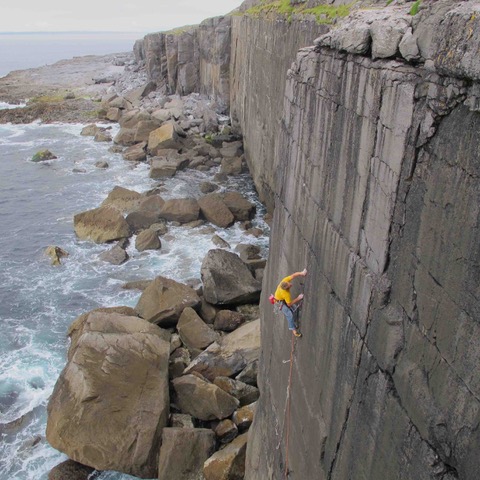
Charlie on Damn The Torpedoes (E6 6b), The Burren. Photo: Charlie Woodburn Collection
Can you tell us a bit about your film work, hanging out of helicopters?
I’ve worked as a camera assistant for nearly 25 years, and have also specialised in working in the aerial unit for 15 years. I work as a technician with gyro-stabilised systems that incorporate any kind of film or digital movie camera, to film the aerial sequences of a production. The system I was initially trained on was called a Wescam, which had a fixed 35mm camera installed. These days, the systems are more advanced and can incorporate any production camera and lens from Red, Alexa, 35mm, 65mm and IMAX.
My job involves everything from rigging the external brackets to the aircraft, assembling the necessary camera, lens, platform package, assembling the internal cockpit layout, tuning, balancing and calibrating the system, and then working as a First Assistant cameraman on the shoot, i.e. loading film, overseeing lab instructions, pulling focus where necessary, blah blah blah.
I’ve been lucky enough to be involved in some exciting productions, and it's taken me to some interesting parts of the world. Last year I worked on the latest Bond film No Time To Die, and over the years I’ve worked on films like Harry Potter, Black Hawk Down, Tomb Raider, Blood Diamond and Body of Lies. What I particularly like about the aerial unit is that clearly it's not studio based, and that because of the noise of the helicopters, we rarely shoot sequences involving sound, i.e. involving the principle actors. This means that most of what we shoot is the stunts, and so it can be quite dramatic to watch. Mostly I don’t fly these days, but sometimes when needed.
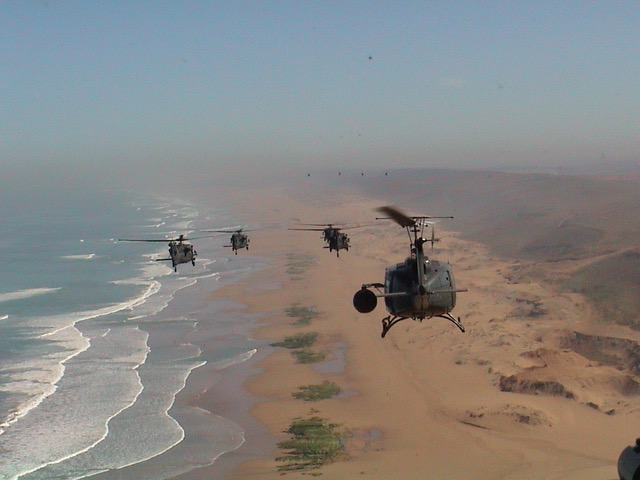
Charlie filming as part of the film Black Hawk Down. Photo: Charlie Woodburn Collection
Charlie can be found on Instagram here.




